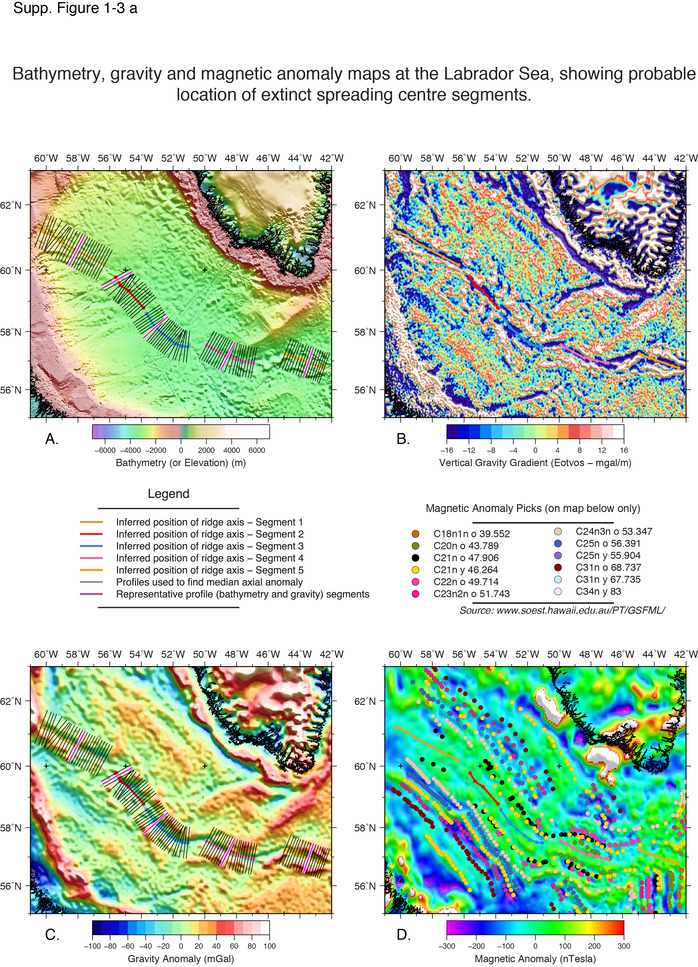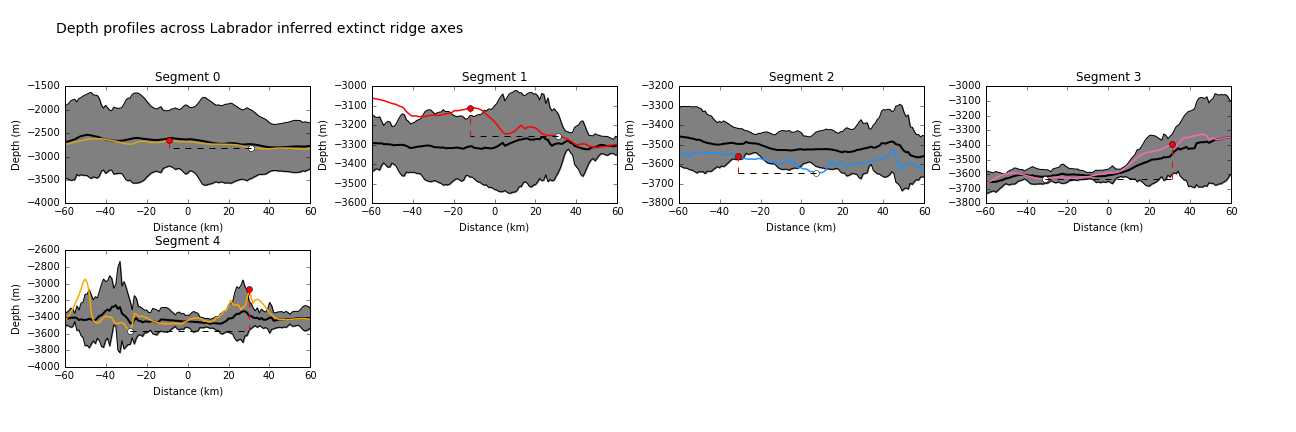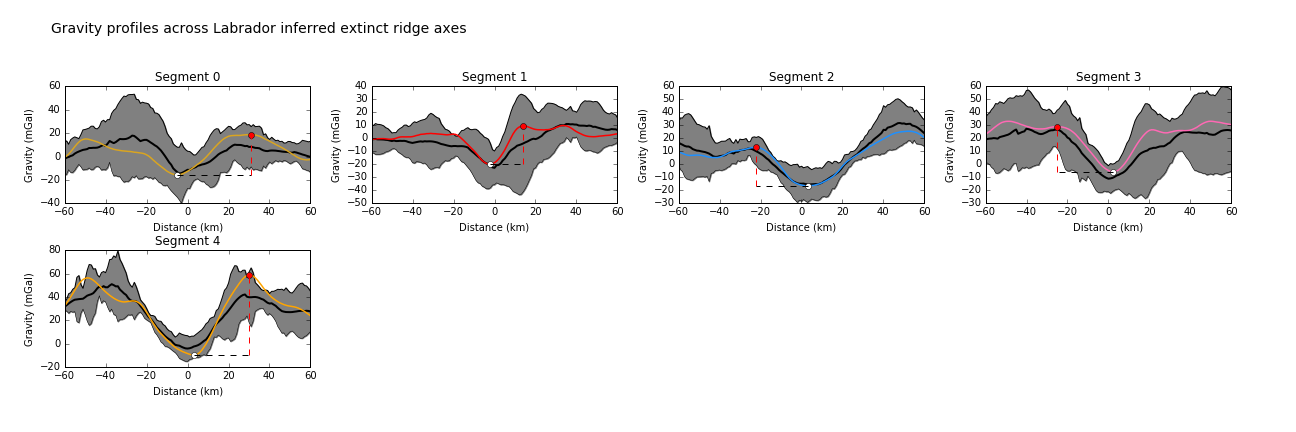| Ocean: | Northern Atlantic Ocean |
| Spreading center type: | Large-scale extinct MOR |
| Time of cessation: | Ca. 33.5 Ma, Chron C13 (Srivastava, 1978) |
| Subsequent active spreading center: | The Reykjanes-Kolbeinsey ridge is likely to have been active simultaneously with the Labrador Sea ridge, and continued spreading after its extinction. |
| Cessation style: | Gradual reduction in spreading rate from Chron 21 to chron 13 (Osler, 1993) |
| Later deformation/volcanism | None evident |
The Labrador Sea was one of the earliest reported extinct ridges (Le Pichon et al., 1971). The presence of an extinct spreading center was inferred from a linear gravity low in the center of the bay that matched a basement high observed in several seismic refraction profiles (Le Pichon et al., 1971). Detailed magnetic surveys were available shortly after its initial identification (Vogt and Avery, 1974; Kristoffersen and Talwani, 1977; Srivastava, 1978), however debate has continued regarding the oldest magnetic anomalies in the Labrador Sea margin because of uncertainty as to the position of the continent-ocean boundary. Numerous subsequent studies have been undertaken in the region to better constrain its history. Seismic reflection studies in the region have allowed interpretation of sediment thickness and crustal structure within the region (Hinz et al. 1979).
The possible cause of the gravity low at the extinct spreading axis has been debated, with some authors arguing that it is due to thickened oceanic crust at the axis and others arguing for thinned crust and serpentinized mantle accounting for the density anomaly (Welford and Hall 2013) . Welford and Hall 2013 observe that the complex faults off-setting the ridge axis offer a means by which extensive serpentinization may have occurred.
Evolution of the Labrador Sea spreading system and the triple junction between the North American, Greenland and Eurasian plates in the North Atlantic have been debated at length, with some authors suggesting that the Iceland plume contributed to the commencement and cessation of spreading in the Labrador Sea (Gerlings et al., 2009). Christopher et al. (2011) suggest that the intersection of the elongate Baffin Bay and Labrador Sea spreading systems with thick continental crust to the north was the most significant barrier to continued oceanic spreading.
Two independent gravity inversion studies have been undertaken in recent years to estimate crustal thickness in the Labrador Sea. Welford and Hall (2013) used gravity inversion to consider the tectonic structure of the extinct spreading center, relative to the surrounding crust and margins, whereas Hosseinpour et al. (2013) developed crustal thickness grids to assist in estimating continent-ocean boundaries and stretching factors at continental margins in order to improve their kinematic reconstruction. Neither of these recent gravity inversion studies resolves a crustal thickness anomaly at the ridge axis, although a seismic refraction study by Osler and Louden (1992) suggested that the crust is thinned and potentially altered to serpentinite, as evidenced by low velocity zones near the axial structure. Osler and Louden (1992) observed that the axial segments of the extinct ridge are structurally similar to an amagmatic fracture zone. They attribute the crustal structure to temporal reduction in magmatic supply to the axis, resulting in a poorly developed lower crust (ibid). Several studies argue that the latest phase of spreading in the Labrador Sea was at ultra-slow spreading rates, with minimal magmatic accretion betwen chrons C20 and C13 (Srivastava, 1978; Osler, 1993; Osler and Louden, 1995).
Osler and Louden (1995) describe the cause of ridge cessation as a significant change in the regional geometry of plate boundaries. They propose that a major change occurred at around 69 Ma, when Greenland began to separate from Eurasia and the Iceland hotspot was active in the Davies Strait between mid-western Greenland and Baffin Island. The final stages of spreading are thought to have extended from anomaly 21 to anomaly 13, considerably longer than previously thought, and at very low spreading rates (Osler and Louden 1995).
Sedimentary deposits have buried the Labrador Sea extinct ridge and the morphology of the axial structure is not evident from bathymetric profiles through the global dataset (GEBCO_2014_1D, version 20141103; Weatherall et al., 2015). However, the extinct ridge axial segments are defined by free-air negative gravity anomalies that have peak-to-trough magnitudes of approximately 30 mGals, with half-width that vary from 16 to 20 km. The ridge is segmented into a number of axial segments approximately 300 km in length, which are offset by a small distance.
Gerlings, J., Funck, T., Jackson, H. R., Louden, K. E., Klingelhofer, F., 2009, Seismic evidence for plume-derived volcanism during foramtion of the continental margin in southern Davis Strait and northern Labrador Sea, Geophysical Journal International, v. 176, p. 980-994.
Hinz, K., Schlüter, H.-U., Grant, A. C., Srivastava, S. P., Umpleby, D. and Woodside, J, 1979, Geophysical transects of the Labrador Sea: Labrador to southwest Greenland, Tectonophysics, v. 59, pp. 151-183.
Hosseinpour, M., Müller, R. D., Williams, S. E., and Whittaker, J. M. 2013, Full-fit reconstruction of the Labrador Sea and Baffin Bay, Solid Earth, v. 4, p. 461-479.
Kristoffersen, Y. and Talwani, M., 1977, Extinct triple junction south of Greenland and the Tertiary motion of Greenland relative to North America, Geological Socity of America Bulletin, v. 88, p. 1037-1049.
Le Pichon et al. 1971, Geophysical study of the opening of the Labrador Sea, Journal of Geophysical Research, v. 76, no. 20, p. 4724-4743.
Osler, J. C. and Louden, K. E., 1992, Crustal structure of an extinct ridge axis in the Labrador Sea: preliminary results from a seismic refraction study, Earth and Planetary Science Letters, v. 108, p. 243-258.
Osler, J. C. ,1993, Crustal structure of the extinct ridge axis in the Labrador Sea: Implications for dynamic models of flow beneath mid-ocean ridges, Ph.D. thesis, Dalhousie University, Halifax, Nova Scotia.
Osler, J. C. and Louden, K. E., 1995, Extinct spreading center in the Labrador Sea: Crustal structure from a two-dimensional seismic refraction velocity model, Journal of Geophysical Research, v. 100, no. B2, p. 2261-2278.
Christopher, T., Pulvertaft, R. and Dawes, P. R., 2011, North Atlantic spreading axes terminate in the continental cul-de-sacs of Baffin Bay and the Laptev Sea, Canadian Journal of Earth Science, v. 48, p. 593-601.
Srivastava, S. P., 1978, Evolution of the Labrador Sea and its bearing on the early evolution of the North Atlantic, Geophysical Journal of the Royal Astronomical Society, v. 52, p. 313-357.
Vogt, P. R. and Avery, O. E., 1974, Detailed magnetic surveys in the Northeast Atlantic and Labrador Sea, Journal of Geophysical Research, v. 79, no. 2, p. 363-389.
Weatherall, P., Marks, K. M., Jakobsson, M., Schmitt, T., Tani, S., Arndt, J. E., Rovere, M., Chayes, D., Ferrini, V., Wigley, R., 2015, A new digital bathymetric model of the world’s oceans. Earth and Space Science, v. 2, no. 1, p.331–345, doi: 10.1002/2015EA000107.
Welford, J. K. and Hall, J. 2013, Lithospheric structure of the Labrador Sea from constrained 3-D gravity inversion, Geophysical Journal International, v. 195, p.767-784.


